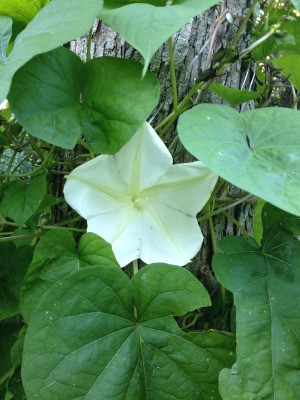
This page contains the following solutions.
The moonflower vine (which will be considered Ipomoea alba throughout this post) is a beautiful plant; a bit mysterious, too. I have read numerous internet accounts of this vine. The most consistent fact in these accounts is the inconsistency in their 'facts'. Even the origin of the moonflower vine is in question. Though it has been introduced to many temperate regions of the world, such as India, where it is highly prized; we can assume by the nature of the plant, its origin is tropical, most likely, the New World tropics.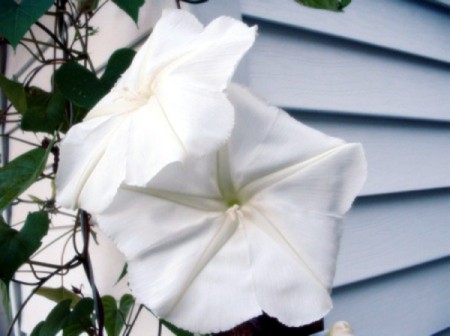
Note: Earlier, the moonflower vine was classified as Calonyction aculeatum, and is still sold by some seedsmen under this name. However, according to Wikipedia, it has been "properly reassigned" to the genus Ipomoea Quamoclit. Oddly enough, Wikipedia also lists the cardinal vine, aka, the cypress vine, as Ipomoea quamoclit. Until the taxonomists come to terms with the name of the moonflower vine, I will refer to it as, the widely accepted and probably more correct, Ipomoea alba.
Having read so many articles on this vine, I can only assume most are simply copied versions of articles found elsewhere on the net. Incorrect information is re written as fact and passed along, yet again. For example, most of these numerous articles cite the moonflower vine as being toxic or poisonous.
For the sake of brevity, I will not list the four web pages I found citing the moonflower vine as edible, and extractions from same used internally to treat certain disorders. I will, in the interest of those who would like to grow this vine, but hesitate due to fear of safety in doing so, present two facts attesting to the innocuous nature of this plant.
Some of you will remember my little friend, Robbie, the orphaned rabbit. In a post I made earlier, I said Robbie was an 'anyvore', because he would eat anything. Indeed, I mentioned he had been eating the leaves of my moonflower vine. At least two months later, he was still alive and appeared quite healthy.
When the vines began to bloom, I remembered witnessing Robbie eating the leaves. Being confident there was no harm, I selected the largest bloom. I ate the whole bloom. I suffered absolutely no ill effects. Two months later, I am alive and quite well for my age.
What with the four accounts from reputable sources, citing the edibility of this vine, even the young seed, and with my own personal ingestion of it's flower, and with Robbie relishing it's leaves, I think no matter how many articles you read citing it's toxicity, you can grow this beautiful vine without fear or worry. Just be sure you are growing moonflower vine, Ipomoea alba, and not some of the other plants commonly termed 'moonflower', which indeed, are poisonous.
As to the misinformation contained in most articles on this plant, the words of an old friend come to mind: 'Doug, don't you know a piece of paper will lay there and let you write anything on it?'.
I've had moonflower vines climb my trees and attain a height of 50 feet. A lot of people who appreciate this flower may not grow them for that reason. Some may not have any structure for the vines to climb.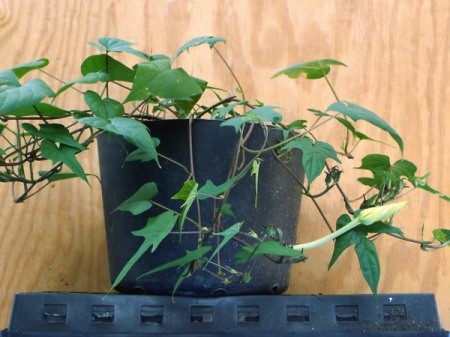
I have good news for those people. It may be common knowledge to many gardeners, but new to me is the fact that the vine will grow quite well, and bloom, in a container. It just occurred to me that they should do well on a trellis of 6 feet or so. I say that because once the vine has reached the desired height, it can be pruned. Cutting back the new, long runners seems to force the vine to produce even more blooms.
If you have been hesitant to grow the moonflower vine because of the heights it can reach, do know it can be kept in a container and it's ultimate height can be whatever you choose. Imagine having a pot of these on your patio, covered in blooms, and filling the air with it's heady fragrance.
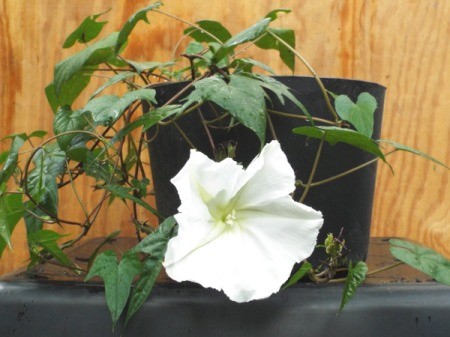
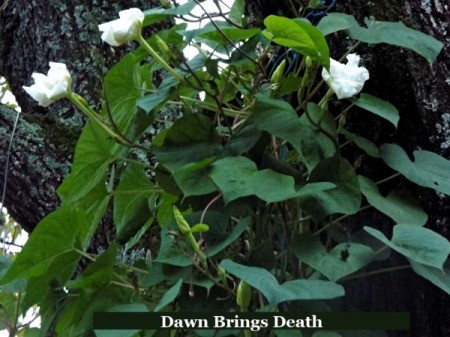
Members have written in, complaining that their moonflower vines were taken by frost just before they were about to bloom. I told them the vine requires a long growing season.
Last Fall, I collected seed from the dried seed pods on the vine pictured here. I brought the seed inside and put them in a saucer to dry for three days.
Here are the questions asked by community members. Read on to see the answers provided by the ThriftyFun community.
Can someone tell me where I can locate seeds or the plant in Northeast Dallas area?
By Barbi S
Last year I grew moonflowers, and late in the fall I harvested a couple of dozen seeds from the purple-ish pods. I kept them in a cool dry place all winter.
After reading online, I took a dozen or so and soaked them in water overnight, then planted them about 1/2 inch deep in seed starting soil mix in jiffy pots. It's been about 3 weeks and none of them have germinated.
I put the rest in the fridge so they'd have a brief cold season. I then separated them into three groups of four: 1) soaked in water, put in soil, then placed on a seed-starting heat pad; 2) soaked in water in the fridge for two days, then put in soil and on the heating mat, and 3) placed the seeds in soil-filled jiffy pots, then placed in the fridge for another 24 hours. These were not put on the heating pad.
It's now been a week, and I have yet to see any sign of germination. It seems I tried everything (except for nicking the seeds) and had no luck. Any idea what I did wrong? Is it possible to dig up the seeds, nick them, and put them back in the pots? Or is it possible that somehow these seeds were not viable?
By Jimbeaux
I can appreciate that you did several trials. Much has been learned by doing this. However in this case, It didn't seem to help.
I have never refrigerated seed. I have frozen some seed if I knew a cold treatment was required for germination. When a cold treatment is required, it is usually for seed whose natural growing region has quite cold winters.
With that in mind, remember that the moonflower vine is native to the more tropical regions, Northern Argentina and Mexico, etc. I doubt it's seed would need a cold treatment. Your seed may not be viable and the cold treatment may be the reason.
I consulted J L Hudson, one of the most reputable seedsman in this country. If a particular seed needs a cold treatment, he will be sure to advise you of accordingly. He does not mention a cold treatment for The Moonflower Vine (Calonyction aculeatum (=Ipomoea alba) in his catalogue. Also, he has stated that he stores all his seed in glass jars at room tempreature.
If I were you, I would just chalk all this up to experience and start all over with fresh seed. Hudson has them for $2.00 plus the cheapest shipping you'll find anywhere. I bought my last pack at Wal Mart for about the same price.
Here is an excerpt from Hudson's catalogue....and good luck!
Calonyction (kal-o-NIK-tee-on)
Convolvulaceae. Large twining half hardy perennials grown as annuals for their large and showy, fragrant, trumpet-shaped, night-blooming flowers. They are beautiful free-flowering vines, their night-scented blooms make them excellent for covering trellis work by summer porches and bedroom windows. Nick seed or soak overnight in warm water till swollen. Germinates in about 2 weeks. Sow early and plant out in May. Easy.
Calonyction aculeatum (=Ipomoea alba).
You can see a picture of Moonflower vine I started indoors, here.
wwwsrc.thriftyfun.com/
We live next door to a llama/alpaca farm. Is it safe to plant these along their fence line?
By Pam M.
Moonflowers are extremely toxic to all animals. Do not plant them. I would suggest this website for some pretty and unusual flower seeds.
Contact them with any questions regarding the flowers' toxicity and benefits to butterflies, hummingbirds and other animals. Also, whether or not the flowers would work well in your geographic location. I've found them to be a great resource.
I received dried moonflower seeds from a plant in Dallas. I put some in pots with potting soil and planted some directly in the ground without nicking and soaking. It's been about 2 weeks now and none have sprouted. I have done an online search and everyone says to nick the seeds. These seeds are so tiny it's about impossible to nick them.
I now have a few that have been soaking for about three days and they don't look any different from the day I starting soaking them. Are the seeds in the packets that you buy any bigger? I'm in zone 7, west Texas. What am I doing wrong?By Betty
I did not nick mine but I did soak them. It took a long time for them to come up but once they did they are growing fast.
Betty
Depending on the weather and other factors, it may be normal that your seed haven't come up yet. I'd give them one more week.
When you were doing your research online, did you happen to view any pictures of the seed? The seeds are not tiny. They are as large as a good size English pea. You should have no trouble nicking them. I never soak or nick mine. It really isn't necessary. All it does is speed up the germination time by a day or two.
Below is a picture of a Moonflower Vine seed.
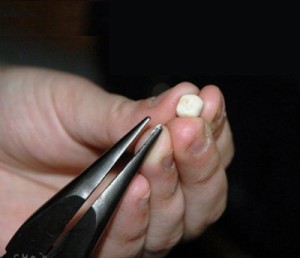
Hardiness Zone: 5a
Joyce from Janesville, WI
Moonflower seeds pods are easy to identify. As the flowers fade you will see large purplish-colored pods. Some gardeners like the looks of them and leave them attached to the vines, while other cut them off. To save moonflower seeds, collect the pods once they turn brown and start to crack open. If you're worried about frost before the pods dry out completely, remove them and finish drying them inside. Inside the pods will be hard, cream-colored seeds. These seeds sometimes take a while to dry, so you may want to store them over winter in paper bags to ensure they get some air circulation. In the spring, nick the seeds slightly and soak them overnight in warm water. This will help speed up the germination process before you plant them. Start the seeds indoors for transplanting or sow them directly into the ground once danger of frost is well past.
Ellen
While they are green and about to pop open, you will see many seeds. Drop them where you want them ,to grow, or just let them fall to the ground, and they will come up next Spring.
After the flowers fall off, there will be a seed ball form. They will get to approximately the size of a golf ball and have little spine like on them. Clip the stem and put them in a dry place to dry out. After the pods are dried, you can remove the seeds and put them in a container to plant the next season. I hope this helps.
I always let my plants reseed themselves which may be a mistake because the plants can
get real invasive thru the season. Next year I will collect some of the pods off the ground.
I did hear this summer that when cutting the plants back wear gloves because the juices plant are that ooze out of thehallucinagetic, not sure to what but better safe than sorry.

(sent in by email)
The flowers fell off & i don't see no seeds or pods on them & i wanted to
plant them in a different place next year.
Joyce
Moon Flower seeds - Shouldn't be a problem collecting seeds as every flower makes a seed pod. So they are there all season. Plus remember that these seeds [toxin] famous for its mind altering properties. I have grown them, they smell wonderful. I always wash my hands when I have handled the plant.
I planted moonflower seeds, how long do they take for germination?
Hardiness Zone: 7a
By Marie Huskins from Murfreesboro, TN
I think they take a while. I live in Central Florida. If I remember correctly, it took a while, maybe even 10 days or so, but I planted them directly in the soil. Then the plant started to grow and vine. By mid-summer it bloomed. I believe I bought the seed from Martha Stewart at Kmart. Good Luck!
Hey, did you soak them? I soaked mine overnight and I think they took about what the package said, maybe a bit longer. I kept them pretty well watered also.
Ok that is what I did , put them right in the ground, I will keep checking them, thanks for the info, I got my seeds at Walmart.
Thanks,
Marie
Surprisingly I have had great luck sprouting moonflower seeds which are six years old between pieces of moist paper towel. Then I will transfer to peat pots. My question is this, when one sprouts, it sends out a white worm like looking thing.
It grows. Will this be the future root? If so, I should place in plant with that part going down, right? Thanks!If you cut back the moon flower bloom to the pot will it grow again in the spring?
By Albert R
Check out these photos.
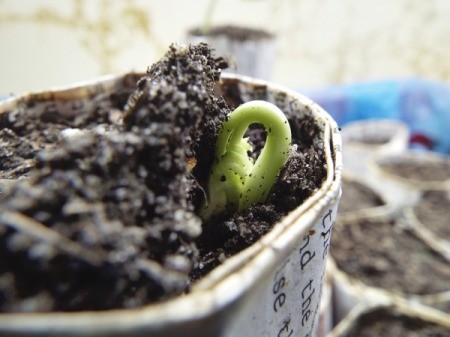
Photo Description I think I can. I think I can. And yes! Hello World! Hey, wanna know something, Y'all? I can move a mountain. No really. I just did! Stop laffin' Y'all. Got what on my face?
Man, this ain't easy. It feels like there's a mountain on my shoulder. There is a mountain on my shoulder!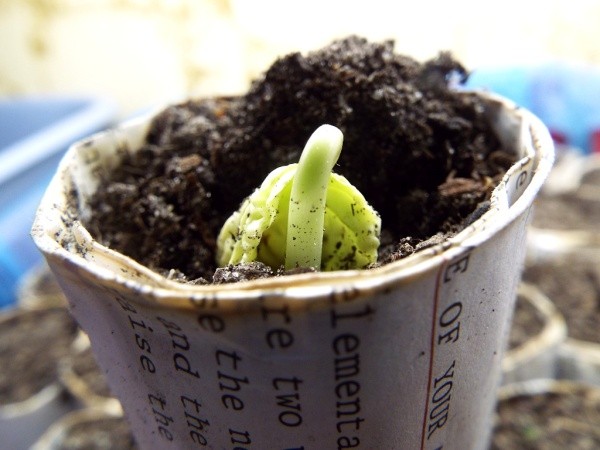
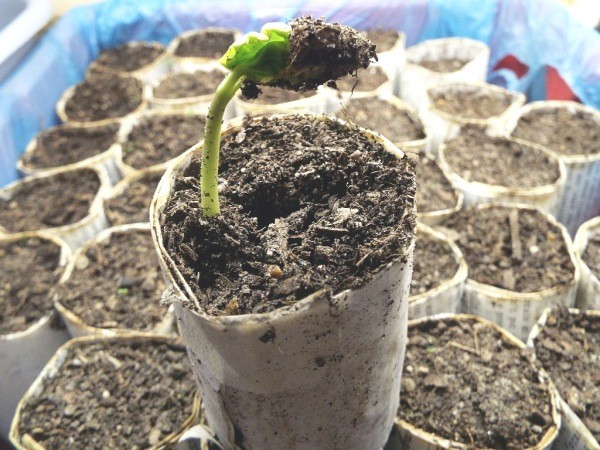
Some time back, I posted a short article on how confusing some common flower names can be. The editors titled the article 'Avoiding Confusion with Common Flower Names'. My point was, sometimes one flower may have several common names and if this is the case, using the botanical name would rule out confusion. Here is an excerpt from that article:
"There are probably ten different flowers for which people use the common name 'Angel Trumpet', including 'Datura', 'Brugmansia' and several lilies including 'Crinum'. When they say 'Angel' or 'Devil Trumpet', I never know which flower they mean. In this case, I think it's best to call Datura by it's botanical name, Datura".
A lot of times, using the botanical name rules out any confusion. I think it's at these times, you should learn and use the botanical name, particularly if it's easy to pronounce.
Well, it seems my tip was a good one, after all. Some time after I posted my tip, ThriftyFun posted a guide titled 'Growing Moonflowers'. The article was accompanied by a picture of a white flower. That white flower has the botanical name 'Datura stramonium'. It is probably the most common variety of Datura, as there are many.
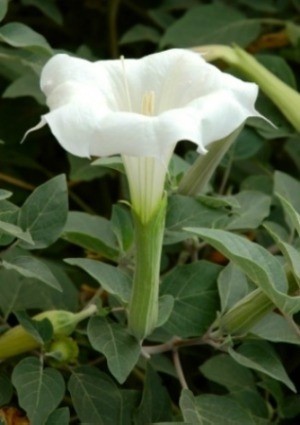
This description of the article was placed along side the picture:
'Add some night interest and a lovely fragrance to your garden with the beautiful moonflower which opens just before dusk. This is a page about growing moonflowers'.
(I hope to make several corrections about flower names, here. My first is: The pictured flower 'Datura stramonium' does not have a "lovely fragrance". The slight scent it does have is rather unpleasant. The flower does not open just at dusk. It may open anytime, day or night).

The Datura has several common names. It is often called 'Angel Trumpet' or Devil's Trumpet'. Other common names are 'Jimson Weed' and 'Loco Weed'. It was only after rereading this article and researching that I discovered the Datura has yet another common name, that being 'Moonflower'.
When this article was composed, it had included in it, an article I had previously posted, titled 'Starting Moonflower Vine Seed'. A question posed was 'Are Moonflowers Toxic to Animals'? 'Best Answer': Moonflowers are extremely toxic to all animals.
I found a very short video on YouTube about 'getting high' with Moonflower seed. The opening and closing pictures were of Moonflower vine seed. All pictures in between were of the seed or seed pod of Moonflower (Datura).
(If you are thoroughly confused by now, you are not alone. So was the author of that video and the editors at ThriftyFun (Bless their hearts), as well as a lot of other people who write articles about these two plants).
My second correction is actually a set of corrections:
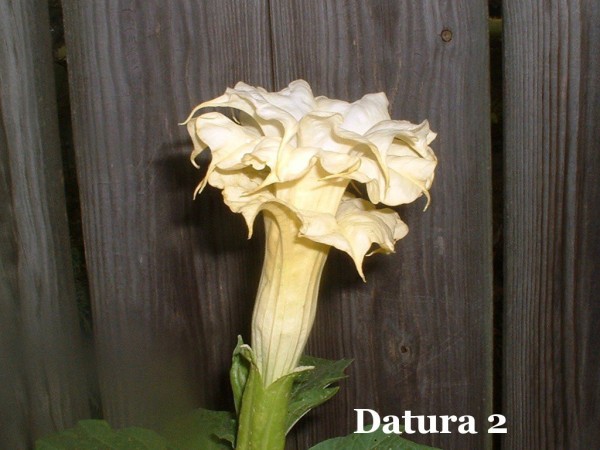
Datura, also called Angel Trumpet, Devil's Trumpet, Jimson Weed, and Moonflower does not open just at dusk. It has an unpleasant scent. Though not usually considered deadly, it is poisonous and contains hallucinogenic properties. Cattle have been known to 'go crazy' after ingesting Datura. That's how it came by another common name, Loco Weed.
On the other hand, Ipomoea alba, the Moonflower Vine also commonly called Angel Trumpet, Devil's Trumpet, etc. does open late evening. It's perfume is so pleasant, it is often planted by doorways. It is in fact related to the sweet potato and morning glory. The young leaves and the seed are eaten and prepared in several ways.
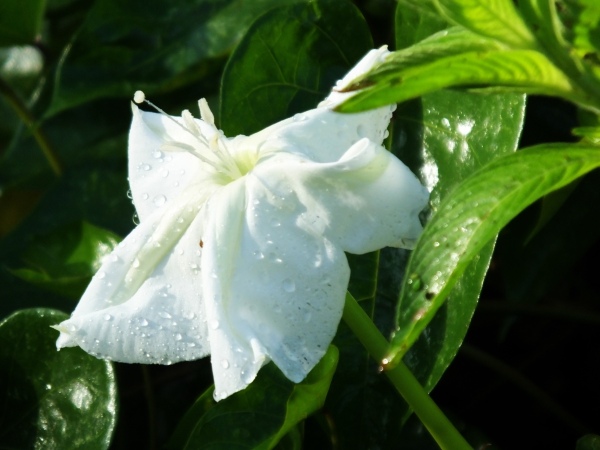
I think a lot of the confusion arose when Datura was given the common name, Moonflower.
In conclusion:
So why would anyone call both these flowers by one common name, mainly Angel Trumpet? Not only is it confusing, it could be dangerous if you ate one of them.
If you grow either of these two flowers, or two others also commonly called 'Angel Trumpet', the pictures below may be of help. I still say "Sometimes, it's better to call a flower by it's botanical name, especially if that name is easy to pronounce". So, Datura is 'Datura", and Ipomoea alba is Moonflower vine.
I have also included links to pronunciation of the words Brugmansia, Crinum, and Datura. Say 'Brugmansia' ten times and you will own that word for life.
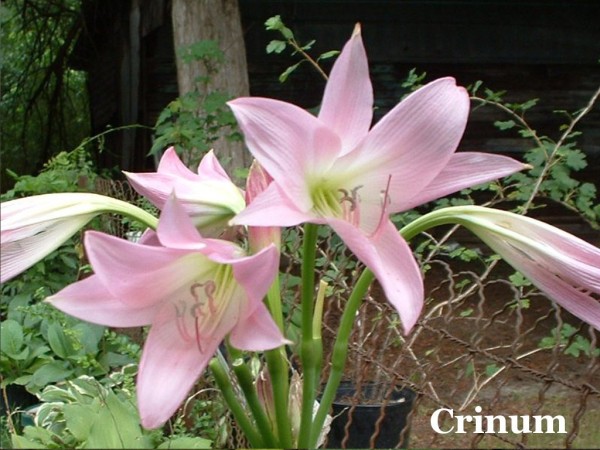
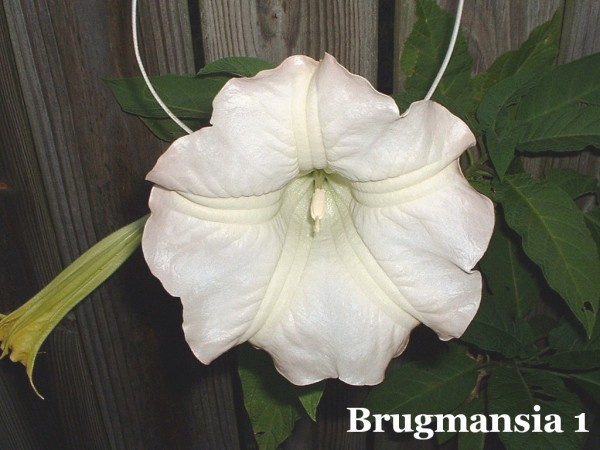
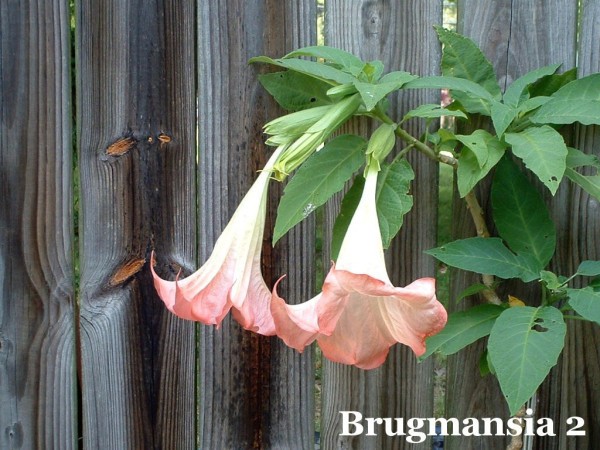
Editor's Note: We have corrected our "Growing Moonflowers" guide to reflect all the different names that are used to describe moonflowers. Night blooming cereus (hylocereus) is also commonly referred to as moonflower.
I planted these last year and they came back. I love them! I wish I would have planted them in my angel garden; I may do that in the fall.
I was thinking an alternative title for this piece might be: Can You Bottle This Stuff? I believe it's essence would make an interesting perfume. It would have to be 'cleaned up' a bit, though. It is nice and heady, but muddled.
Whether they are ipomoea, datura or cereus, these night blooming flowers can be seen in the light of the moon. This is a page about my blooming moon flowers.